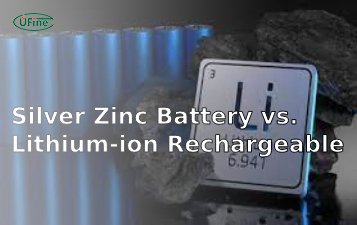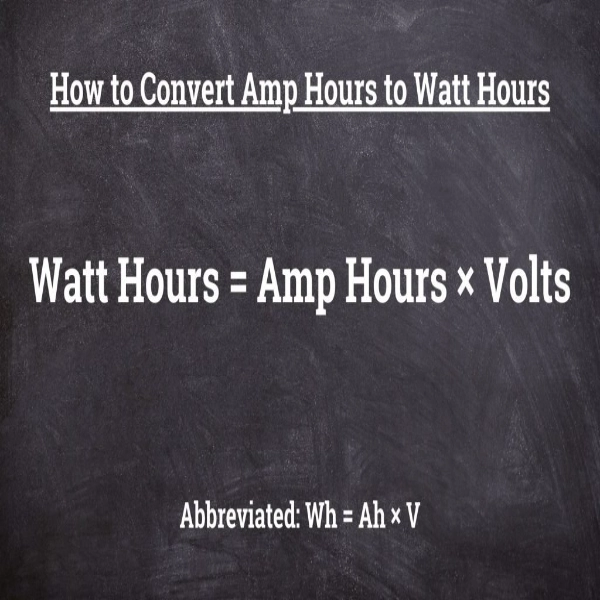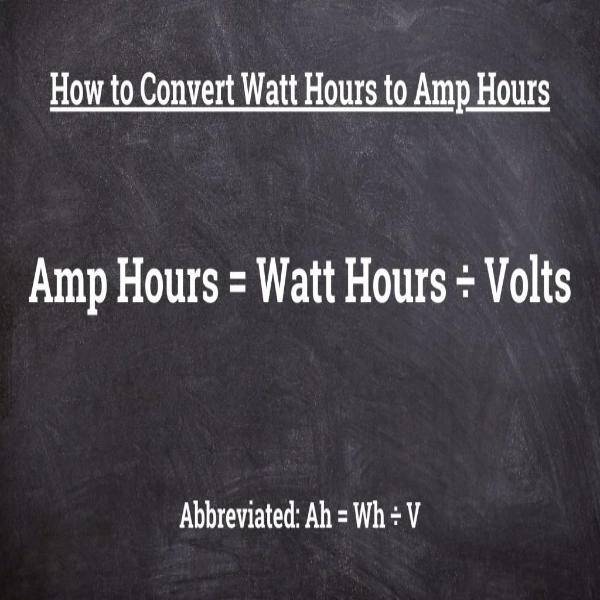
Regarding understanding energy capacity and battery performance, two commonly used terms are watt hours (Wh) and amp hours (Ah). Knowing how to convert between these units is essential for evaluating and comparing different batteries, especially in applications such as electric vehicles, renewable energy systems, and portable electronics. This article will delve into the definitions of watt-hours and amp-hours, explore the calculations involved, and provide practical examples to help you effectively convert between these two units.
Part 1. Understanding Watt hours
A watt-hour (Wh) is a unit of energy capacity representing the energy a device or battery can deliver over time. It is calculated by multiplying the voltage (V) by the current draw (I) in amperes (A) and then multiplying the result by the time in hours (h). In simpler terms, a watt-hour is the energy consumed or produced by a device that operates at a constant power of one watt for one hour.
Calculation of Watt Hours
To calculate the watt hours of a device or battery, you need to know the voltage and the current draw. The formula for calculating watt hours is as follows:
Watt Hours (Wh) = Voltage (V) × Current Draw (I) × Time (h)
For example, let’s say you have a device that operates at a voltage of 12 volts (V) and draws a current of 2 amperes (A) for 5 hours (h). The calculation would be:
Watt Hours (Wh) = 12 V × 2 A × 5 h = 120 Wh
In this case, the device has an energy capacity of 120 watt-hours
Part 2. Explaining Amp hours
An amp hour (Ah) is a unit of battery capacity representing the charge a battery can deliver over time. It indicates the total amount of current that a battery can supply for one hour before reaching its fully discharged state. An amp hour measures how long a battery can sustain a specific current draw.
Calculation of Amp Hours
To calculate the amp hours of a battery, you need to know the energy capacity in watt-hours (Wh) and the voltage. The formula for calculating amp hours is as follows:
Amp Hours (Ah) = Watt Hours (Wh) ÷ Voltage (V)
For instance, if you have a battery with an energy capacity of 240 watt hours (Wh) and an operating voltage of 12 volts (V), the calculation would be:
Amp Hours (Ah) = 240 Wh ÷ 12 V = 20 Ah
In this example, the battery has a capacity of 20 amp hours.
Part 3. How do you convert Amp hours to Watt hours?
Converting amp hours (Ah) to watt hours (Wh) involves multiplying the amp hours by the voltage. Let’s consider an example to illustrate the process:
Suppose you have a battery with a capacity of 30 amp hours (Ah) and an operating voltage of 24 volts (V). To calculate the watt hours, you would use the following formula:
Watt Hours (Wh) = Amp Hours (Ah) × Voltage (V)
Applying this formula to our example, we get:
Watt Hours (Wh) = 30 Ah × 24 V = 720 Wh
Therefore, a battery with a capacity of 30 amp hours and a voltage of 24 volts has an energy capacity of 720 watts.
Part 4. How do you convert Watt Hours to Amp Hours?
Converting watt hours (Wh) to amp hours (Ah) requires dividing the watt-hours by the voltage. Let’s consider an example to illustrate the process:
Suppose you have a device with an energy capacity of 250 watt-hours (Wh) and operate at 12 volts (V). To calculate the amp hours, you would use the following formula:
Amp Hours (Ah) = Watt Hours (Wh) ÷ Voltage (V)
Applying this formula to our example, we get:
Amp Hours (Ah) = 250 Wh ÷ 12 V = 20.83 Ah
Therefore, a device with an energy capacity of 250 watt-hours and a voltage of 12 volts has a battery requirement of approximately 20.83 amp hours.
Part 5. What to consider when choosing a battery?
Energy Needs Assessment
- Understand the concepts of Watt Hours (Wh) and Amp Hours (Ah) to assess energy needs accurately.
- Determine the power consumption of your devices and the duration of operation.
- Match the battery’s energy capacity to your device’s power requirements for optimal performance.
Efficiency and Runtime
- Higher Watt Hours provide a more significant energy reserve, allowing for extended device operation.
- Higher Amp Hours indicate the battery’s ability to sustain a specific current draw for extended periods.
- Choose a battery with appropriate Watt and Amp Hours to ensure efficient and desired runtime.
- Consider the power demands of your devices when selecting battery capacity.
- Opt for higher-capacity batteries for high-power devices and lower-capacity batteries for low-power devices.
Part 6. Final thoughts
In conclusion, understanding the conversion between watt-hours and amp-hours is crucial for accurately assessing energy capacity and comparing battery performance. By mastering these calculations, you can make informed decisions when selecting batteries for various applications.
Part 7. FAQs
-
How many watt hours is 100Ah?
To calculate watt hours from amp hours, multiply the amp hours by the voltage. If the voltage is 12 volts, 100Ah would be 100Ah * 12V = 1200 watt-hours. -
How do you calculate power rating in watts?
Power rating in watts is calculated by multiplying the voltage (in volts) by the current (in amperes). So, P (power in watts) = V (voltage in volts) * I (current in amperes). -
How do you calculate watts per hour from watts?
Watts per hour isn’t a standard unit; however, if you mean watts over time (like watt-hours), you multiply the power in watts by the time in hours. If you have a device that uses 100 watts continuously for 2 hours, it would be 100 watts * 2 hours = 200 watt-hours. -
What is the difference between watt-hour and watt-per-hour?
Watt-hour (Wh) measures energy consumed or stored over time, while watt per hour (W/h) isn’t a standard unit. It’s more appropriate to talk about watts (power) per hour, which would be the rate of change of control over time. -
Is a 4.0 Ah battery better than a 2.0 Ah battery?
It depends on the application. A 4.0 Ah battery can store twice as much energy as a 2.0 Ah battery, so if you need more energy storage capacity, the 4.0 Ah battery would be better.
Related Tags:
More Articles

What is the Difference Between Silver Zinc Battery vs. Lithium-ion Rechargeable?
Compare silver zinc and lithium-ion rechargeable batteries: energy density, cycle life, safety, cost, and uses in drones, medical devices, EVs, and electronics.
What are Watts and Watt Hours in Battery?
Understand watt vs watt-hour in batteries: key differences, how to calculate capacity, and why they matter. Includes free comparison table.
Best 10 Blood Pressure Monitor Battery Review: Finding the Most Reliable
Are you looking for a reliable Blood Pressure Monitor battery? Here is a complete guide with the top 10 best blood pressure monitor batteries.
Bluetooth Headphone Battery Guide: All You Need to Know
Maximize headphone battery life with expert tips! Learn how to charge, check, troubleshoot, and choose the best bluetooth headphone battery in 2025.
LiFePO4 Battery VS. Lithium-ion Polymer Battery: Which One Is Best?
Comprehensive comparison of LiFePO4 vs Lithium Ion Polymer batteries: energy density, safety, lifespan, cost. Find out which battery suits your needs in 2025.





